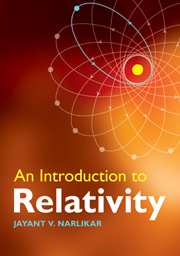Book contents
- Frontmatter
- Contents
- Preface
- 1 The special theory of relativity
- 2 From the special to the general theory of relativity
- 3 Vectors and tensors
- 4 Covariant differentiation
- 5 Curvature of spacetime
- 6 Spacetime symmetries
- 7 Physics in curved spacetime
- 8 Einstein's equations
- 9 The Schwarzschild solution
- 10 Experimental tests of general relativity
- 11 Gravitational radiation
- 12 Relativistic astrophysics
- 13 Black holes
- 14 The expanding Universe
- 15 Friedmann models
- 16 The early Universe
- 17 Observational cosmology
- 18 Beyond relativity
- References
- Index
13 - Black holes
Published online by Cambridge University Press: 05 June 2012
- Frontmatter
- Contents
- Preface
- 1 The special theory of relativity
- 2 From the special to the general theory of relativity
- 3 Vectors and tensors
- 4 Covariant differentiation
- 5 Curvature of spacetime
- 6 Spacetime symmetries
- 7 Physics in curved spacetime
- 8 Einstein's equations
- 9 The Schwarzschild solution
- 10 Experimental tests of general relativity
- 11 Gravitational radiation
- 12 Relativistic astrophysics
- 13 Black holes
- 14 The expanding Universe
- 15 Friedmann models
- 16 The early Universe
- 17 Observational cosmology
- 18 Beyond relativity
- References
- Index
Summary
Introduction
We found in the previous chapter that, if a massive star runs out of nuclear fuel, it would lose its equilibrium and begin to shrink. Even when nuclear fuel is available to the star, it may be insufficient to meet the demands for the star's equilibrium. In the early 1930s the young astrophysicist Subrahmanyan Chandrasekhar had encountered a somewhat similar situation when discussing the state of stars like the Sun, after they run out of their nuclear fuel. He found that the star can still sustain equilibrium if its internal matter can attain the degenerate state. Degeneracy can arise if the density of matter is so high that all available energy levels of atoms are filled up, up to some low energy. In such a situation further compression of matter is not possible and gravity is held at bay. This is an excellent example of a macroscopic effect of quantum mechanics: a star as massive as the Sun feels an effect whose origin is in quantum mechanics. We cannot describe it in detail since that would take us farther away from our present interest.
The early work on degenerate matter by R. H. Fowler had shown that every star on sufficient compression attains degeneracy, thereby ensuring that the star would rest in peace in a state of very high density and small radius. It was felt that white dwarf stars are precisely the stars which are in this state.
- Type
- Chapter
- Information
- An Introduction to Relativity , pp. 194 - 222Publisher: Cambridge University PressPrint publication year: 2010



